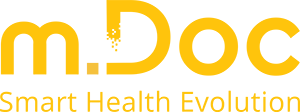At least since the KHZG, numerous hospitals in Germany have been thinking about introducing a patient portal – or have even implemented one already. But how good are the digital solutions really and where do they offer added value for doctors, nursing staff, patients?
“Creating immense relief for patients”.
One thing you have to hand it to the legislators: The funding elements of the KHZG with all the mandatory and optional criteria are well thought out and have one overriding goal: to bring patient care back into focus. In particular, funding criterion 2, the patient portals, pays significant dividends toward this goal. This is presumably one reason why, with a total of 1,130 applications, it ranks second in the funding category, directly after digital documentation.
A well-designed patient portal is much more than just a “hotline” to patients – especially if it is holistic, i.e., without media discontinuities and with a high level of user-friendliness for all users. Patient portals have to overcome this “hurdle” twice, because on the one hand they should make it as easy as possible for patients, most of whom are already in poor health, and at the same time they should not place an additional burden on hospital staff, but – on the contrary – should relieve them. And they already do this at the time of admission, which patients can complete from the comfort of their own homes and then arrive in the hospital itself on the “fast lane” to the ward, just like at the airport check-in.
The common thread for the hospital stay
For the hospital staff, this means that all important information about a patient, her previous medical history, medication, surgery – if one is planned – and even meals during her stay are clarified in advance. All information is transferred to the hospital information system (HIS) via interfaces and is thus available to doctors and nurses. This well thought-out procedure, which has already been automated to a large extent, runs like a thread through the entire hospital stay with a patient portal, right up to discharge management and possible aftercare.
Wherever a patient portal is already in use, doctors, nurses and, above all, patients are enthusiastic about the benefits of this digital communication and data processing. And this enthusiasm was clearly evident at this year’s DMEA in Cologne.
Great interest at digital health trade show DMEA
There was a huge crowd at our stand – especially at the screens, which visitors could use to immerse themselves in the multi-faceted world of Smart Clinic, m.Doc’s patient portal, via touchscreen. But it was above all the many expert discussions with interested and sometimes profound questions that convinced us that the inpatient sector has understood the benefits of a patient portal independent of KHZG funding and wants to use them for itself. For example, Steffen Grebner, head of the central procurement management department at Hannover Region Hospital, emphasized in a conversation at DMEA that people are increasingly paying attention to process costs, i.e., to the fact that new solutions relieve the burden on doctors, nursing staff and other employees at the hospital. Dr. Pascal Grüttner, head of the IT department at Hospitalvereinigung St. Marien GmbH and vice chairman of the Digital Health Germany association, was particularly convinced by the independent concept of the Smart Clinic. He said that this could be integrated well into existing systems – long before the KHZG funding.
You can get an even deeper insight into the trade fair happenings around the m.Doc booth in the video at the beginning of the article. In it, you will learn, among other things, what the experts at DMEA have to say about patient portals in general and the Smart Clinic in particular.

